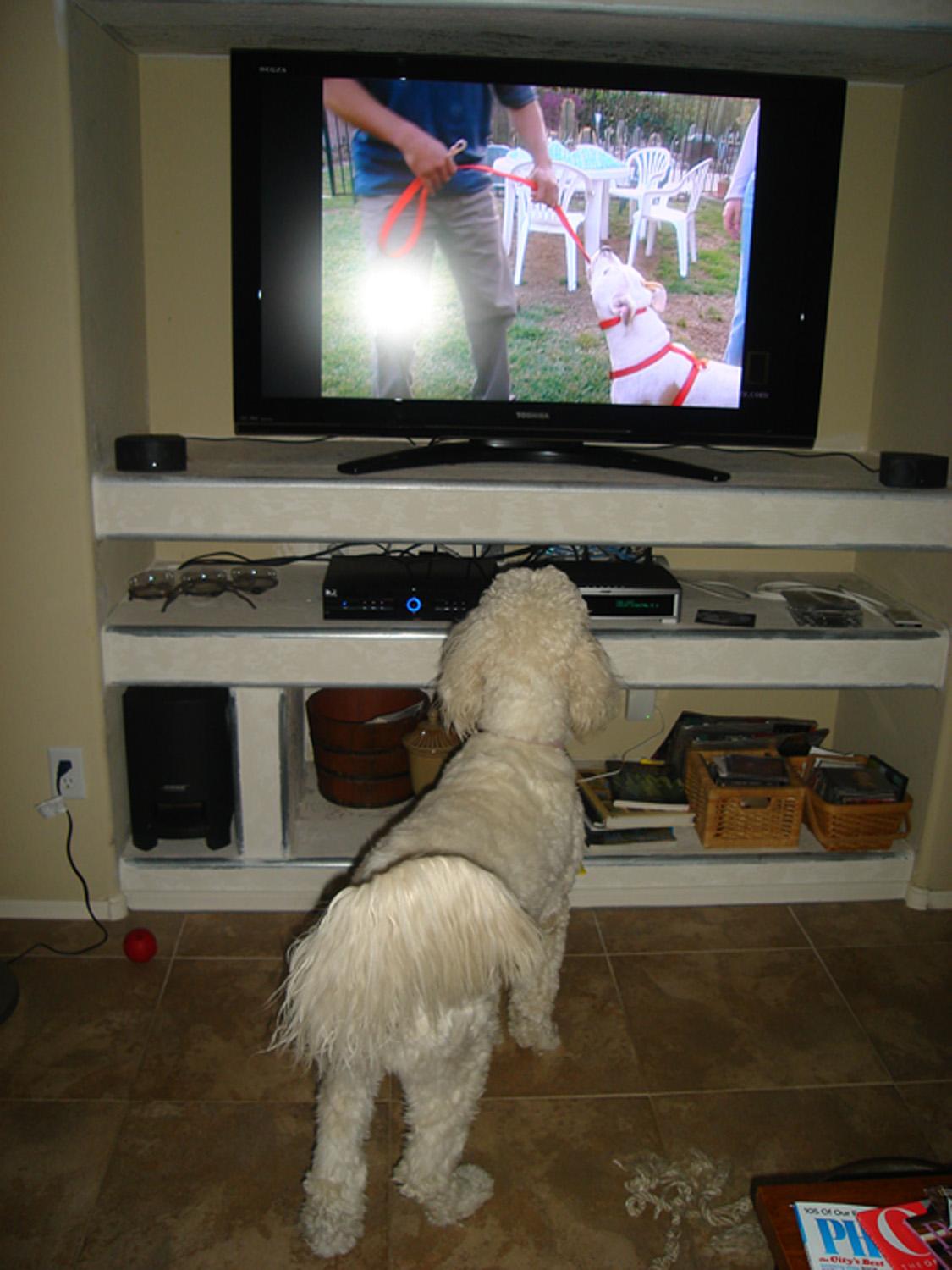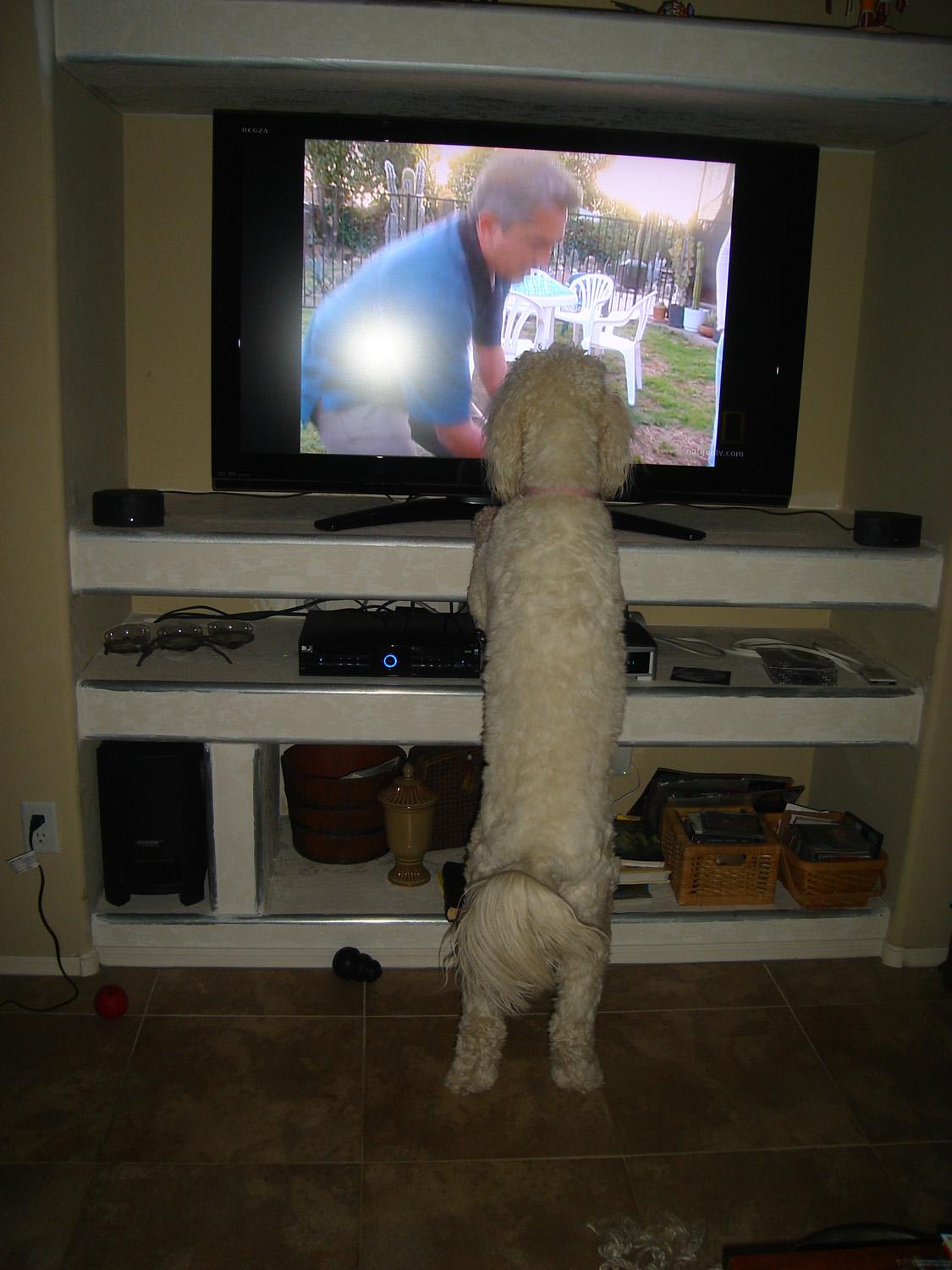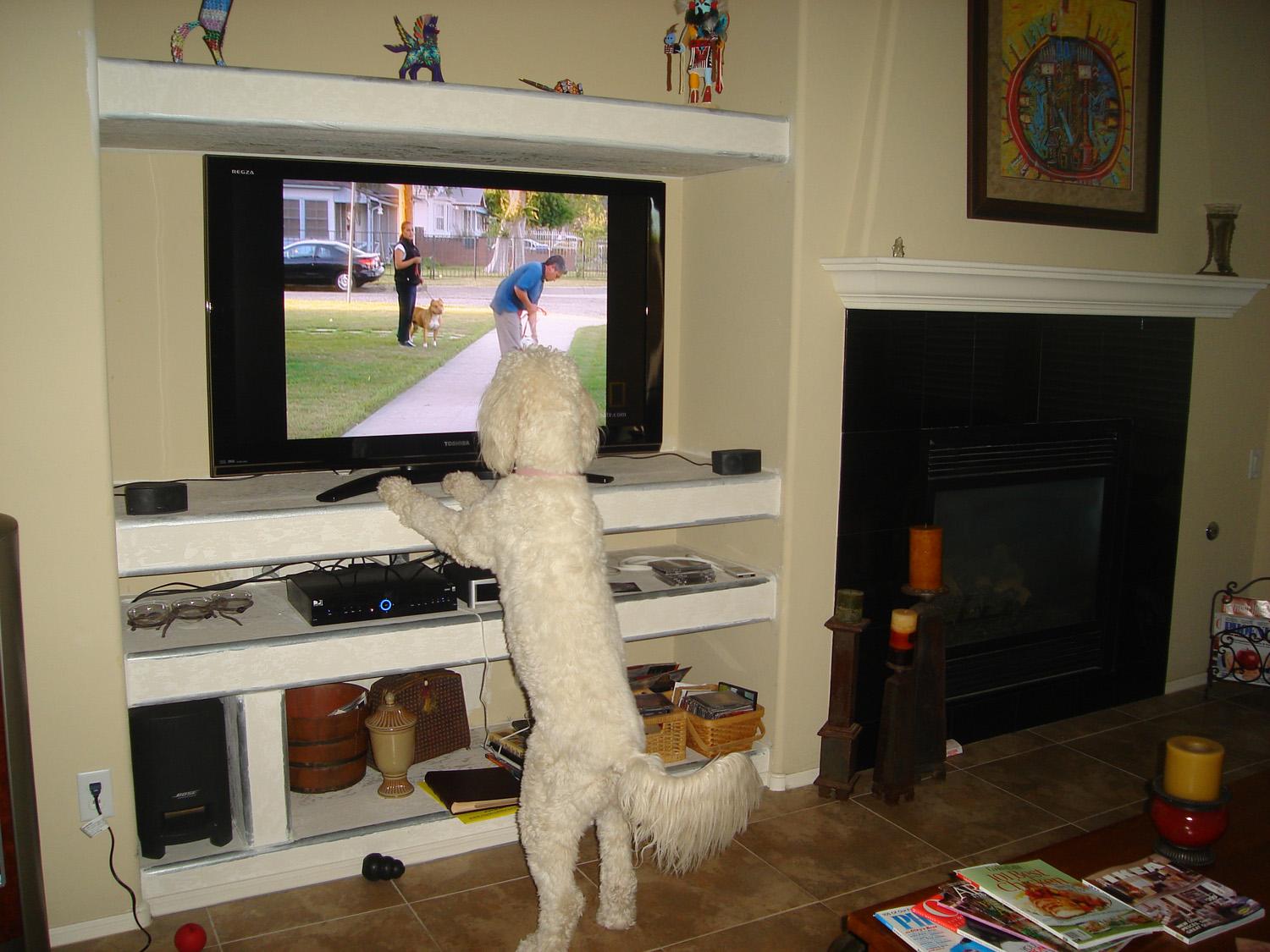Archives for Dog Training category
Posted on Dec 15, 2009
Behavioral Modification, Dog Humor, Dog Psychology, Dog Smile, Dog Training, Dogs and Cognitive Learning, Dogs Express Emotion
It is fascinating to read the studies on the analysis of dogs and their expression of emotion. We, of course, refer to emotion in the sense that we experience it. Dogs; however, live in the moment so their emotion may be more raw than ours. I don’t think they are capable of deceiving us by expressing an emotion they aren’t really feeling at the moment. They don’t pretend as well as we do!
There are fun photographs of dogs smiling. And they do! Some more than others, but it still qualifies as a smile. I also have seen more than my share of grumpy-doggy face. The “it’s you again” look on some dogs when I (the trainer) show up for another training session can be very comical – for us humans more so than the dog.
With the cooler temperatures, the dogs seem quite content to cuddle on their beds a little longer than normal. And, some days, I think they get up on the wrong side of their cedar-chipped, double-organic-fiber-stuffed, memory foam dog beds! Perhaps they have bad dreams and restless nights too; so, I will cut them some slack.
Regardless, I think it’s fun to notice that much like a little child, a dog’s expression of “emotion” shifts in a nano-second. In a flash, they go from grump-dog to tail-waggin’-ready-for-a-walk dog. I wish it were that easy for us two-leggers! Once again, we learn from our dogs how blessed it is to live in the moment.
Posted on Dec 11, 2009
Behavioral Modification, Dog Psychology, Dog Training
Is this an ad your dog has placed on Craig’s List or CareerBuilder? Are they looking for someone to be in charge so they can relinquish the responsibility? Are they acting out and resisting your instruction?
Maybe your dog isn’t yet savvy enough to post such an ad, but if you have a dog, there is the need for a confident leader…is it you? If not, who is it? In the words of Cesar Millan, dogs need and respect a calm, assertive leader.
My dogs need to be reminded at times that the position of leader has been filled, and it just so happens that in our home the job belongs to the only one who walks on two legs. I thought since they need to be reminded, maybe you do to.
The primary purpose and goal of my work as a trainer/behaviorist, is to show humans who their dog is and what they are capable of learning. Don’t wait for your dogs to fill the position of leader. Most people fill some position in their life where they lead another. It may take practice, but put yourself in that mindset as you provide (calm, assertive) guidance for your dog.
They may resist at first, but with consistent behavioral expectations from you, they will respect you and remove the job opening!
Posted on Dec 09, 2009
Dog Psychology, Dog Training

Uh, Mo, we’re busted..get up, I think she wants to sit down.
Posted on Dec 05, 2009
Behavioral Modification, Dog Psychology, Dog Toys, Dog Training, Dogs and Cognitive Learning, Dominant Dog, Uncategorized
You may not have thought of a dog as having patience. Well, they do – or at least that’s what I’m calling it.
If one of my dogs has a toy, regardless of the five other toys available, someone will want that exact toy at that exact moment. That’s no surprise. Of course, they want what the other one has. Among these boys, It’s a constant dance of who dominates who.
After a couple of human-to-dog interventions, they know not to mess with one another, or everyone loses (as in I take the toy). See, it’s my toy, and I am kind enough to let them have it. I have also established the rules that go along with toy-play.
This morning, Mac is chewing on a toy as Moby stands patiently by looking for either a safe “in” to get the stuffed creature, or for Mac to get bored and walk away. He will wait longingly for quite awhile before he loses interest. He doesn’t make a sound…waiting patiently for the right moment. I think he actually thinks he “won” if Mac relinquishes the object without care.
I like the thought of that – particularly as we enter the Holiday season. It’s like saying, “I really want what you have, but I’ll just wait patiently while you enjoy it, and when you don’t want it any more, I’ll take it.”
Thoughts of peace and patience to you this season!
Posted on Dec 04, 2009
Adopt a Shelter Dog, Behavioral Modification, Dog Psychology, Dog Training, Rehoming a Dog
What is the best way to introduce a new dog to the family?
I often hear of dogs who are being re-homed after being with their new family for only a few days. I understand the tension that can exist when you find that your beloved Prince doesn’t like the play mate you hand-picked for him. You were certain that getting another dog was the answer to helping him calm down.
If it were only that easy! All dogs are not created equal (in their minds)…they may want nothing to do with each other and yet separate them and they are wonderful, friendly beings. So, maybe getting a new dog wasn’t the best idea you’ve had, but re-homing too quickly may not be either.
The new dog should be in the home for a few weeks learning and earning their place. With you as the leader, take the introductions slowly. In our enthusiasm, we bring the dog in, introduce it to the other dog and go about our lives expecting (hoping) they will figure it out. Some do and some don’t. They are the ones who end up seeing their face on a “free to good home” ad. Taking the time to let the dog fit in more naturally may save everyone!
If you are bringing a new dog into your home and want to get off on the right track, please send a note in the My Question box to the right, and I will be happy to assist you! (I share the box with Melody)
Posted on Dec 02, 2009
Behavioral Modification, Dog Psychology, Dog Training
It’s a busy time for a lot of people…people who just got a puppy and perhaps forgot how much work it can be! You may be thinking they are puppies, so no big deal. You can train them later.
Have you heard the phrase, “we show people how to treat us?” I would like to include dogs in that! You are training your dog how to be in the home (and elsewhere) whether you think you are or not. The moment you bring them in and for years to come, they will be learning from you.
Please don’t misinterpret this to think I believe we should try to make dogs into good little humans. That will never be – Thank Dog! However, since they are so good at being dogs, we need to use “dog training” in how to adapt to life in a human family. This is always done out of respect for who they are and their inherent behaviors.
Having said that, if your friends have excuses for why they can’t come in or you panic when there is a knock at the door, or during meals, or any other time, you have “trained” your dog. Think of training them as providing consistent, repetitive guidance on what’s good behavior in the home and in relationship to their surroundings.
We have all walked into someone’s home and it was obvious that it was the dog’s home and he was kind enough to let the humans stay. That’s not the fault of the dog. I don’t necessarily think it’s healthy for the dog or humans either!
As dogs mature and go through their hormone shifts, they will have new responses and can be affectionately referred to as teenagers. This is when consistency on your part is so important. A consistent, positive, persistent approach will do a lot more than a raised voice and frustration.
So, as you go about your day, remember that you are training your dog…the question is how?
Posted on Nov 19, 2009
Behavioral Modification, Dog Psychology, Dog Training, Dogs and Cognitive Learning
Do dogs want to please us? Do they reason? We tend to think they must want to please us because of their enjoyment of our affection. We have all witnessed behavior that would indicate dogs have the ability to reason. The ongoing research regarding canine cognition is sure to reveal scientifically what we can only assume based on what we see. However, there needs to be care taken not to assume dogs think, reason, learn, or respond as humans do. We are setting someone up for failure to think otherwise.
As I work with dogs and their humans on a daily basis, I see frustration in the human’s eyes and confusion in the dog’s as the human is certain their dog knows exactly what is being asked and they are just being stubborn. Can they be stubborn? Absolutely. They can also be confused, and our escalating impatience will not help to clarify our expectations.
An example: dogs are taught to sit with the human facing them. Soon, they are sitting every time we ask. Then, we take the leash and are out for a walk and as we stop we ask our beloved dog to sit and demonstrate their new skill. Not only do they not sit, they act clueless. What happened? We moved. Dogs are constantly in tune with our bodies. They learned sit with us facing them and they think that is part of the command.
Rather than getting frustrated, make sure they understand what “sit” means and that it has nothing to do with the proximity or position of your body or a treat. Once they really know the word and the associated response, they will sit regardless of where you are standing in relationship to them. When certain they understand the command and they are either distracted or stubborn, ask them to sit once and then assist them in sitting. They must follow through!
There is more to say on this topic, and that will be covered in another post. Until then, if you have any questions regarding the training of your canine companion, please send a note in the box to the right. (I share with Melody)
Posted on Nov 14, 2009
Behavioral Modification, Dog Psychology, Dog Training
Some dogs have a very strong prey drive. You don’t take or “train” that out of them; rather you work with it. It can be especially challenging when working on their recall or teaching them to come when called. Be patient, consistent with training, and follow through with the command as they mature. You will gain their respect and pleasing you will become more important than whatever the prey may be.
The dog in the photo below has a strong prey drive whether or not the animal has blood flow. He downed a bear and though extremely exhausted, came when called, dragging the bear to his bed where he fell asleep.

Posted on Nov 10, 2009
Behavioral Modification, Dog Humor, Dog Psychology, Dog Training
Lola, a beautiful Goldendoodle belonging to a friend of mine living in Arizona, has been trained by Cesar Millan! While I would like to receive a little credit for her obedient behavior, I have to admit the credit goes to Cesar, the Dog Whisperer (as if I needed to add his title).
The amazing aspect of her training is that she never met Cesar! I wouldn’t have believed it if I hadn’t seen it for myself. The photos below tell the story and show that she is smarter than your average Goldendoodle! Here is she is being “personally” trained by Cesar Millan.

I like to carry my leash but this dog looks like he is trying to play tug-of-war with Cesar. Even I know that’s not a good idea!

Forget that loser dog, Cesar – look at me! I’m Lola! I luff you!

You say it, Cesar, and I’ll do it! I’m a good girl!
Posted on Nov 04, 2009
Aggression, Behavioral Modification, Dog Park, Dog Psychology, Dog Training, Palm Springs Dog Park
When at a dog park, it’s not the dogs I am concerned about! It’s their humans. Dogs are excellent at being dogs. Take them to a dog park without them responding to you, and you will really get to witness dogs in action. They aren’t being bad by being a dog – they are doing what they know to do until we teach them to be what we call a “good dog.” Dog parks are filled with more scents and pent-up energy than we can imagine.
I was working with an aggressive dog outside of the dog park. I was a safe distance from the entry room with the dog nicely in a sit-stay. A car drives up, opens their door, and lets three dogs run out off leash. My guess is the dogs are not well-trained so trying to keep them on a leash to enter the park would have been a challenge.
All three dogs ran toward us. I said nicely, “we are in training and the dog is aggressive toward dogs.” May I remind dog park lovers that it’s not always a good situation to have dogs off leash charging toward dogs who are leashed without knowing about the dogs. That’s why before entering the park, the dogs have an area for leash removal. There is absolutely no way of knowing every dog in every situation – especially, if someone is telling you they have a dog-aggressive dog. A nice, friendly dog doesn’t make a dog-aggressive dog change it’s ways!
The man still could not get control of his dogs but kept assuring me that, “that one is friendly.” Which one is “that one” and what about my saying several times this dog is aggressive didn’t he understand. Fortunately, nothing happened. He was swatting at the dog calling it bad, and if I had a spare leash, it would not have been put on the dog!
I write this as a reminder to everyone to be responsible with your dogs. Have them on a leash if they are not trained to be off leash. I know the dog park is the highlight of the day for some dogs, but that will soon change if there is an altercation that could have easily been prevented.













